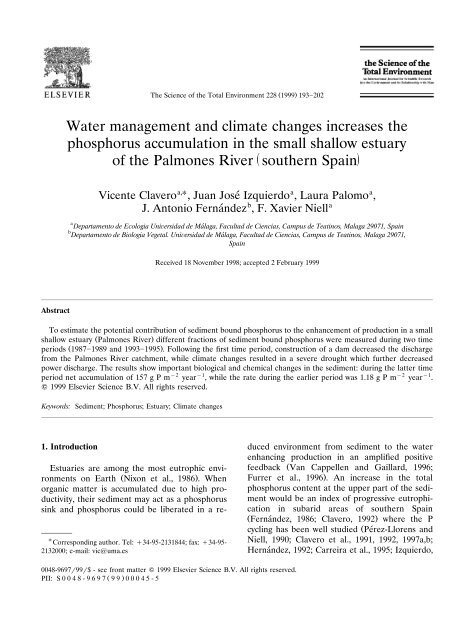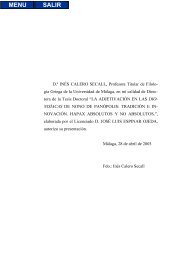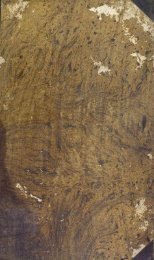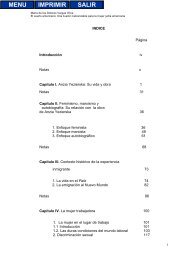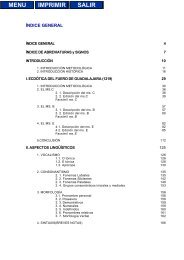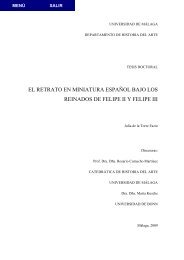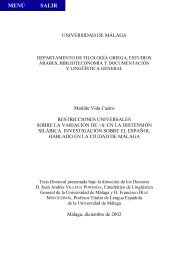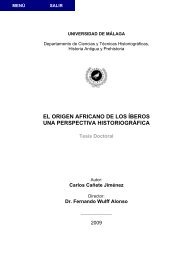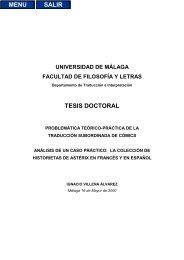Water management and climate changes increases the phosphorus ...
Water management and climate changes increases the phosphorus ...
Water management and climate changes increases the phosphorus ...
You also want an ePaper? Increase the reach of your titles
YUMPU automatically turns print PDFs into web optimized ePapers that Google loves.
Abstract<br />
Ž .<br />
The Science of <strong>the</strong> Total Environment 228 1999 193202<br />
<strong>Water</strong> <strong>management</strong> <strong>and</strong> <strong>climate</strong> <strong>changes</strong> <strong>increases</strong> <strong>the</strong><br />
<strong>phosphorus</strong> accumulation in <strong>the</strong> small shallow estuary<br />
of <strong>the</strong> Palmones River ž sou<strong>the</strong>rn Spain/<br />
´<br />
Vicente Claveroa, , Juan Jose Izquierdoa , Laura Palomoa ,<br />
J. Antonio Fern<strong>and</strong>ezb , F. Xavier Niella ´<br />
a<br />
Departamento de Ecologia Uniersidad de Malaga, ´ Facultad de Ciencias, Campus de Teatinos, Malaga 29071, Spain<br />
b<br />
Departamento de Biologia Vegetal. Uniersidad de Malaga, ´ Facultad de Ciencias, Campus de Teatinos, Malaga 29071,<br />
Spain<br />
Received 18 November 1998; accepted 2 February 1999<br />
To estimate <strong>the</strong> potential contribution of sediment bound <strong>phosphorus</strong> to <strong>the</strong> enhancement of production in a small<br />
shallow estuary Ž Palmones River. different fractions of sediment bound <strong>phosphorus</strong> were measured during two time<br />
periods Ž 19871989 <strong>and</strong> 19931995 . . Following <strong>the</strong> first time period, construction of a dam decreased <strong>the</strong> discharge<br />
from <strong>the</strong> Palmones River catchment, while <strong>climate</strong> <strong>changes</strong> resulted in a severe drought which fur<strong>the</strong>r decreased<br />
power discharge. The results show important biological <strong>and</strong> chemical <strong>changes</strong> in <strong>the</strong> sediment: during <strong>the</strong> latter time<br />
period net accumulation of 157 g P m 2 year1 , while <strong>the</strong> rate during <strong>the</strong> earlier period was 1.18 g P m2 year1 .<br />
1999 Elsevier Science B.V. All rights reserved.<br />
Keywords: Sediment; Phosphorus; Estuary; Climate <strong>changes</strong><br />
1. Introduction<br />
Estuaries are among <strong>the</strong> most eutrophic environments<br />
on Earth Ž Nixon et al., 1986 . . When<br />
organic matter is accumulated due to high productivity,<br />
<strong>the</strong>ir sediment may act as a <strong>phosphorus</strong><br />
sink <strong>and</strong> <strong>phosphorus</strong> could be liberated in a re-<br />
<br />
Corresponding author. Tel: 34-95-2131844; fax: 34-95-<br />
2132000; e-mail: vic@uma.es<br />
0048-969799$ - see front matter 1999 Elsevier Science B.V. All rights reserved.<br />
Ž .<br />
PII: S 0 0 4 8 - 9 6 9 7 9 9 0 0 0 4 5 - 5<br />
duced environment from sediment to <strong>the</strong> water<br />
enhancing production in an amplified positive<br />
feedback ŽVan<br />
Cappellen <strong>and</strong> Gaillard, 1996;<br />
Furrer et al., 1996 . . An increase in <strong>the</strong> total<br />
<strong>phosphorus</strong> content at <strong>the</strong> upper part of <strong>the</strong> sediment<br />
would be an index of progressive eutrophication<br />
in subarid areas of sou<strong>the</strong>rn Spain<br />
Ž Fern<strong>and</strong>ez, ´ 1986; Clavero, 1992. where <strong>the</strong> P<br />
cycling has been well studied ŽPerez-Llorens<br />
´<br />
<strong>and</strong><br />
Niell, 1990; Clavero et al., 1991, 1992, 1997a,b;<br />
Hern<strong>and</strong>ez, ´ 1992; Carreira et al., 1995; Izquierdo,
194<br />
( )<br />
V. Claero et al. The Science of <strong>the</strong> Total Enironment 228 1999 193202<br />
1996 . . <strong>Water</strong> <strong>management</strong> is a paramount problem<br />
in subarid countries, <strong>and</strong> <strong>the</strong> construction of<br />
water reservoirs is a frequent <strong>management</strong> tool.<br />
In <strong>the</strong> early 1980s a dam was built in <strong>the</strong> upper<br />
part of <strong>the</strong> Palmones River which started to store<br />
water in 1987. The normal rainfall in <strong>the</strong> catchment<br />
area Ž averaged for <strong>the</strong> last 30 years. ranged<br />
from 800 to 1050 mm year1 , however, in <strong>the</strong> last<br />
3 years Ž 19931995. <strong>the</strong>re has been a persistent<br />
1 drought, 718 mm year Ž Carreira et al., 1995 . .<br />
As a consequence of both situations two main<br />
transformations in <strong>the</strong> catchment area of <strong>the</strong><br />
Palmones River have occurred in recent years: Ž. 1<br />
<strong>the</strong> reduction of <strong>the</strong> river discharge by <strong>the</strong> construction<br />
of <strong>the</strong> dam in its upper part <strong>and</strong> Ž. 2<br />
climatic <strong>changes</strong> which led to a severe drought<br />
which affected <strong>the</strong> flow of water in <strong>the</strong> river<br />
between <strong>the</strong> dam <strong>and</strong> <strong>the</strong> estuary. The water flow<br />
decreased in <strong>the</strong> estuary from 8 m 3 s 1 in 1987 to<br />
3 1 Ž .<br />
4 m s in 1995 Carreira et al., 1995 . Simultaneously<br />
<strong>the</strong> input of <strong>phosphorus</strong> increased as a<br />
consequence <strong>and</strong> an increase in <strong>the</strong> levels of total<br />
<strong>phosphorus</strong> in <strong>the</strong> sediment should have been<br />
expected over <strong>the</strong> same period. The decrease of<br />
freshwater input changed <strong>the</strong> tidal exchange <strong>and</strong><br />
<strong>the</strong> input of phosphate by tidal flux also contributes<br />
to increased eutrophication ŽClavero<br />
et<br />
al., 1997a . . Studies of <strong>phosphorus</strong> cycling in estuarine<br />
sediments have mainly been based on measurements<br />
of phosphate or total <strong>phosphorus</strong> concentrations<br />
Ž Lebo <strong>and</strong> Sharp, 1992 . . However,<br />
data on <strong>changes</strong> of various <strong>phosphorus</strong> fractions<br />
Žcalcium bound to <strong>phosphorus</strong> <strong>and</strong> non-calcium<br />
Table 1<br />
Comparison of some physiographical characteristics of <strong>the</strong><br />
estuary over <strong>the</strong> two time periods considered<br />
2<br />
19871989 19931995<br />
Area of drainage basin Ž km . 95 95<br />
Longitudinal extent of estuary Ž km. 3.5 3.5<br />
Tidal range Ž m. 1.0 1.0<br />
1<br />
Tidal frequency Ž day .<br />
1.67 1.67<br />
2<br />
Estuarine surface Ž km .<br />
4.5 3.75<br />
Mean depth Ž m. 2.0 1.5<br />
Tidal rangemean depth Ž m. 0.5 0.66<br />
1<br />
Rainfall Ž mm year .<br />
8001050 25<br />
3 1<br />
River flow Ž m s .<br />
8 4<br />
Area covered by water Ž over 100% . 100 75<br />
bound <strong>phosphorus</strong> <strong>and</strong> organic <strong>phosphorus</strong>. are<br />
scarce in estuarine environments ŽRuttenberg,<br />
1992; Ruttenberg <strong>and</strong> Berner, 1993 . .<br />
In this study, <strong>the</strong> interannual pattern of variation<br />
of <strong>the</strong> different fractions of <strong>phosphorus</strong> in<br />
two periods Ž A. from 1987 to 1989 <strong>and</strong> Ž B. from<br />
1993 to 1995 have been studied <strong>and</strong> will be related<br />
to <strong>the</strong> water <strong>management</strong> strategies since<br />
1987 <strong>and</strong> to <strong>the</strong> climatic <strong>changes</strong> described above,<br />
to predict temporal trends in eutrophication. The<br />
aim of this study is to describe <strong>the</strong> large scale<br />
<strong>changes</strong> observed in <strong>the</strong> sediment of a small shallow<br />
estuary Ž Palmones, Sou<strong>the</strong>rn Spain. by measurements<br />
of <strong>the</strong> different fractions of <strong>phosphorus</strong>.<br />
2. Material <strong>and</strong> methods<br />
2.1. Description of <strong>the</strong> study area<br />
The Palmones River Estuary is located in<br />
Sou<strong>the</strong>rn Spain Ž Fig. 1. at <strong>the</strong> end of a small<br />
catchment area. A comparison of some physiographic<br />
characteristics of <strong>the</strong> estuary during <strong>the</strong><br />
two time periods considered is shown in Table 1.<br />
Palmones is a well mixed shallow estuary Žmaxi-<br />
mum depth 3.5 m. with a range of salinity from 29<br />
to 35 Ž Clavero et al., 1997a . . The flow of freshwater<br />
in <strong>the</strong> Palmones Estuary is dominated by<br />
<strong>the</strong> Palmones River. At 23.5 km from <strong>the</strong> mouth<br />
of <strong>the</strong> estuary is <strong>the</strong> dam mentioned above, which<br />
started to store water in 1987. The results of<br />
transformations cited above <strong>and</strong> <strong>the</strong> severe<br />
drought in <strong>the</strong> last years, induced dramatic modifications<br />
in <strong>the</strong> system Ž Tables 1 <strong>and</strong> 2 . .<br />
2.2. Sampling <strong>and</strong> analytical methods<br />
Sediment cores were taken monthly from March<br />
1987 to November 1989 Ž Clavero, 1992. <strong>and</strong> quarterly<br />
from March 1993 to March 1995, using three<br />
PVC core tubes Ž 10 cm i.d., 15 cm long. inserted<br />
by h<strong>and</strong> into <strong>the</strong> sediment, were retrieved <strong>and</strong><br />
covered in both extremes with silicone tops to<br />
minimize <strong>the</strong> contact with <strong>the</strong> air <strong>and</strong> transported<br />
to <strong>the</strong> laboratory in an icebox at 4C. In <strong>the</strong><br />
laboratory <strong>the</strong> sediment was extruded from <strong>the</strong><br />
cores <strong>and</strong> sliced in segments of 2 cm, under N2
( )<br />
V. Claero et al. The Science of <strong>the</strong> Total Enironment 228 1999 193202 195<br />
Table 2<br />
Summary of average annual of some chemical <strong>and</strong> biological<br />
variables analyzed over <strong>the</strong> two time periods considered.<br />
P-flux were indicated as positive when released from <strong>the</strong><br />
sediment to <strong>the</strong> water <strong>and</strong> as negative when <strong>the</strong> P is<br />
accumulated into <strong>the</strong> sediment<br />
19871989 19931995<br />
<strong>Water</strong> column<br />
Phosphate Ž mol l . 2.50.7 8.152.1<br />
Ammonium Ž mol l . 7.82.0 222<br />
Nitrate Ž mol l<br />
Sediment<br />
.<br />
9.81.3 175<br />
Phosphate-flux 217491 27 to 220<br />
Ž 2 1.<br />
Calcium Ž mol l .<br />
300700 25003000<br />
Dissolved phosphate<br />
1 Ž mol l .<br />
165 15035<br />
Organic matter Ž % .<br />
30.8 142<br />
Redox potential Ž mv. 180 220<br />
Inorganic <strong>phosphorus</strong><br />
2 Ž IP, g m .<br />
4.51 19070<br />
Organic <strong>phosphorus</strong><br />
2 Ž OP, g m .<br />
11.81.2 10749<br />
Total <strong>phosphorus</strong><br />
2 Ž TP, g m .<br />
Benthic organisms<br />
16.32.3 297119<br />
Zostera noltii Ž g dry wt. m . 100300 0<br />
Ula rotundata Ž g dry wt. m . 0 50200<br />
Hydrobia ulae Ž ind m . 10005000 700<br />
Nereis diersicolor Ž ind m . 340900 0<br />
1 a b<br />
1 c b<br />
1 c b<br />
a b<br />
mol m day 1 a c<br />
a<br />
See Clavero Ž 1992 . .<br />
b<br />
See Carreira et al. Ž 1995 . .<br />
c<br />
See Clavero et al. Ž 1997b . .<br />
d<br />
This study.<br />
e<br />
See Perez-Llorens ´<br />
<strong>and</strong> Niell Ž 1990 . .<br />
a b<br />
a d<br />
a b<br />
a d<br />
a d<br />
a d<br />
2 e b<br />
2 b b<br />
2 b b<br />
2 a b<br />
atmosphere. Each slice was dried at 60C for 24 h<br />
<strong>and</strong> divided in two subsamples. One was used to<br />
determine <strong>the</strong> inorganic <strong>phosphorus</strong> fractions<br />
Ž Williams et al., 1971 . , non-calcium bound <strong>phosphorus</strong><br />
Ž NAIP. <strong>and</strong> calcium bound <strong>phosphorus</strong><br />
Ž AIP . . NAIP was <strong>the</strong> sum of CDB Žcitrate-<br />
dithionite-bicarbonate. <strong>and</strong> NaOH extractable<br />
<strong>phosphorus</strong> <strong>and</strong> AIP was extracted with HCl on<br />
<strong>the</strong> residue after <strong>the</strong> previous treatment. So, <strong>the</strong><br />
total inorganic <strong>phosphorus</strong> Ž IP. was considered as<br />
<strong>the</strong> sum of both fractions Ž NAIPAIP . .<br />
The second subsample was used to determine<br />
<strong>the</strong> organic <strong>phosphorus</strong> Ž OP. by extraction with<br />
HClNaOH Ž Sommers et al., 1972 . . Soluble<br />
phosphate was determined before <strong>and</strong> after <strong>the</strong><br />
digestion <strong>and</strong> <strong>the</strong> difference represented <strong>the</strong> con-<br />
Ž .<br />
centration of OP Sommers <strong>and</strong> Nelson, 1972 .<br />
All <strong>the</strong> analysis of phosphate were made by means<br />
of <strong>the</strong> malachite green method ŽFern<strong>and</strong>ez<br />
´ et al.,<br />
1985. using a Technicon AAII.<br />
2.3. Statistical analysis<br />
Ž .<br />
Two-way Analysis of Variance 0.05 were<br />
used to compare <strong>the</strong> profiles in depth <strong>and</strong> time of<br />
different fractions of <strong>phosphorus</strong>. Previously <strong>the</strong><br />
data were tested for normality using <strong>the</strong> G-test.<br />
3. Results<br />
Ž 2 The concentrations of AIP g m . over <strong>the</strong><br />
two periods of study are shown in Fig. 2. In <strong>the</strong><br />
period A values ranged between 1.25 <strong>and</strong> 2.50 g<br />
m 2 . Maximum values were recorded in spring<br />
1989 in <strong>the</strong> surface of <strong>the</strong> sediment. During period<br />
B, <strong>the</strong> trend of AIP to increase in <strong>the</strong> sediment<br />
is clear: 40 g m 2 in March 1993 rising to<br />
100 g m 2 in March 1995. In Fig. 3 <strong>the</strong> time<br />
series of NAIP concentrations are presented. The<br />
values during <strong>the</strong> period A ranged between 2.0<br />
<strong>and</strong> 3.0 g m 2 with maximum values at <strong>the</strong> end of<br />
1987 <strong>and</strong> at <strong>the</strong> beginning of 1988. No values<br />
obtained during <strong>the</strong> period A exceeded 3 g m 2 .<br />
During B <strong>the</strong> concentration increased from 50 to<br />
200 g m 2 . The depth profile of this fraction<br />
showed a gradient with significant maximum values<br />
at <strong>the</strong> surface.<br />
The OP was three to four times more abundant<br />
than <strong>the</strong> IP fraction in <strong>the</strong> sediment during A<br />
Ž . 2<br />
Fig. 4 <strong>and</strong> ranged between 10 <strong>and</strong> 14 g m .<br />
Though <strong>the</strong> concentration of OP during B reached<br />
50200 g m2 , an increase up to 15-times, OP<br />
was less than <strong>the</strong> IP fraction Ž Fig. 5. during this<br />
period.<br />
The variations of <strong>the</strong> NAIP, AIP <strong>and</strong> OP with<br />
time <strong>and</strong> depth were analyzed Ž two way ANOVA . ,<br />
separately for each period. The results Ž Table 3.<br />
showed that in both periods NAIP <strong>and</strong> OP concentrations<br />
significantly increased with time <strong>and</strong><br />
depth, whereas only time trends of increase are<br />
significant for AIP values indicating a homogeneous<br />
depth distribution.<br />
3.1. Integrated alues of NAIP, AIP <strong>and</strong> OP in<br />
sediment.<br />
The depth-integrated P concentrations was used
196<br />
( )<br />
V. Claero et al. The Science of <strong>the</strong> Total Enironment 228 1999 193202<br />
Fig. 1. Map of Palmones River Estuary showing location of sampling station.<br />
Ž . 2<br />
Fig. 2. Seasonal <strong>changes</strong> in concentrations of calcium bound <strong>phosphorus</strong> AIP within <strong>the</strong> first 10 cm of sediment. Units are g m .
( )<br />
V. Claero et al. The Science of <strong>the</strong> Total Enironment 228 1999 193202 197<br />
Ž .<br />
Fig. 3. Seasonal <strong>changes</strong> in concentrations of non-calcium bound <strong>phosphorus</strong> NAIP within <strong>the</strong> first 10 cm of sediment. Units are g<br />
m 2 .<br />
to calculate <strong>the</strong> percentage <strong>and</strong> <strong>the</strong> mass balance<br />
of <strong>the</strong> different fractions. The percentages of<br />
each fraction are shown over <strong>the</strong> whole time<br />
study in Fig. 5. During A <strong>the</strong> most abundant<br />
fraction was OP, which accounted for 6478% of<br />
<strong>the</strong> total particulate <strong>phosphorus</strong>; NAIP ranged<br />
between 12 <strong>and</strong> 20% <strong>and</strong> AIP from 8 to 15%. The<br />
percentages during B are similar for NAIP <strong>and</strong><br />
OP, 3741%, whereas AIP accounted only for a<br />
1924% of total. The ratio OP:IP Ž Fig. 6. ranged<br />
between 2 <strong>and</strong> 3.5 during <strong>the</strong> period A <strong>and</strong> is<br />
close to unity during B, expressing <strong>the</strong> progressive<br />
increase of IP relative to CP. The addition of<br />
depth-integrated P concentrations of NAIP, AIP<br />
Ž . 2<br />
Fig. 4. Seasonal <strong>changes</strong> in concentrations of organic <strong>phosphorus</strong> OP within <strong>the</strong> first 10 cm of sediment. Units are g m .
198<br />
( )<br />
V. Claero et al. The Science of <strong>the</strong> Total Enironment 228 1999 193202<br />
Fig. 5. Seasonal <strong>changes</strong> in percentage of <strong>phosphorus</strong> fractions within <strong>the</strong> first 10 cm of sediment, using depth-integrated total<br />
<strong>phosphorus</strong> concentrations.<br />
<strong>and</strong> OP are shown in Fig. 7. During A, OP<br />
concentrations were higher than IP. The OP values<br />
ranged from 9 to 12 g m 2 , NAIP from 1.5 to<br />
2.1 g m 2 <strong>and</strong> AIP from 1 to 1.5 g m 2 . After<br />
1992 all fractions increased, mainly <strong>the</strong> NAIP <strong>and</strong><br />
AIP fractions which increased 75-fold. OP in-<br />
creased 15 times this fraction <strong>and</strong> was more abun-<br />
Ž .<br />
dant in <strong>the</strong> recent observations March 1995 .<br />
3.2. Mass balance calculations<br />
Mass balance was obtained by making <strong>the</strong> integral<br />
from surface to 10 cm in depth P-concentra-<br />
tions, for each fraction <strong>and</strong> time interval. These<br />
values obtained were plotted against time Ž year.<br />
<strong>and</strong> <strong>the</strong> function that exhibited <strong>the</strong> best fit was<br />
searched. The value of <strong>the</strong> first derivative Ž d Pdt.<br />
of this function was considered to be <strong>the</strong> mass<br />
Ž 2 1 balance g P m year . . Comparison of <strong>the</strong><br />
results obtained Ž Table 4. show an increasing<br />
trend for all <strong>the</strong> fractions of <strong>phosphorus</strong>. During<br />
<strong>the</strong> period A, accumulation was estimated at 0.52<br />
gm 2 year 1 of OP; 0.40 g m 2 year 1 of NAIP;<br />
<strong>and</strong> 0.26 g m 2 year 1 AIP, which means a total<br />
<strong>phosphorus</strong> accumulation of 1.18 g m 2 year 1 .<br />
During B, calculated values were 64.16 g m 2
( )<br />
V. Claero et al. The Science of <strong>the</strong> Total Enironment 228 1999 193202 199<br />
Table 3<br />
ANOVA table from <strong>the</strong> data of different fractions of <strong>phosphorus</strong><br />
in <strong>the</strong> two time periods considered<br />
Sv. 19871989 19931995<br />
d.f. Fs d.f. Fs<br />
NAIP<br />
Time 08<br />
a<br />
21.31 06<br />
a<br />
22.7<br />
Depth 05<br />
a<br />
2.52 05<br />
a<br />
3.17<br />
Interaction<br />
AIP<br />
40<br />
a<br />
1.97 30<br />
a<br />
2.1<br />
Time 08<br />
a<br />
49 06<br />
a<br />
31.73<br />
Depth 05 1.1 ns 05 1.2 ns<br />
Interaction<br />
OP<br />
40 0.89 ns 30 0.93 ns<br />
Time 08<br />
a<br />
26.34 06<br />
a<br />
54<br />
Depth 05<br />
a<br />
2.41 05 3 ns<br />
Interaction<br />
TP<br />
40<br />
a<br />
2.2 30 1.03 ns<br />
Time 08<br />
a<br />
11.58 06<br />
a<br />
73.8<br />
Depth 05<br />
a<br />
2.69 05<br />
a<br />
6.5<br />
Interaction 40<br />
a<br />
2.1 30<br />
a<br />
1.98<br />
Note. Source of variation, Sv.; degrees of freedom, d.f.; Mean<br />
a Ž .<br />
squares ratio, Fs; significant, ; not significant ns for 0.05.<br />
year 1 of NAIP; 31.6 g m 2 year 1 of AIP <strong>and</strong><br />
61.42 g m 2 year 1 of OP, <strong>and</strong> total <strong>phosphorus</strong><br />
accumulation was computed as 157 g m 2 year 1 .<br />
4. Discussion<br />
Organic <strong>phosphorus</strong> was <strong>the</strong> most abundant<br />
fraction in <strong>the</strong> sediment at <strong>the</strong> end of <strong>the</strong> 1980s<br />
<strong>and</strong> accounted for 70% of <strong>the</strong> total accumulated<br />
<strong>phosphorus</strong> in <strong>the</strong> sediment of Palmones. These<br />
results do not agree with <strong>the</strong> usual finding in<br />
which <strong>the</strong> concentration of <strong>the</strong> inorganic fraction<br />
is higher than <strong>the</strong> organic one ŽBostrom<br />
¨ et al.,<br />
1982 . . Accumulation of organic <strong>phosphorus</strong> can<br />
occur by rapid <strong>phosphorus</strong> burial. The <strong>phosphorus</strong><br />
profiles Ž Clavero, 1992. found were related to<br />
high productivity in <strong>the</strong> estuary, <strong>and</strong> to <strong>the</strong> consequently<br />
increased organic matter settling on <strong>the</strong><br />
sediment. After 1992 organic matter in <strong>the</strong> sediment<br />
increased fivefold <strong>and</strong> OP since this year<br />
increased ninefold Ž Table 2 . . One possible explanation<br />
of <strong>the</strong> increase of P concentration in <strong>the</strong><br />
sediment above <strong>the</strong> levels expected by organic<br />
matter accumulation could be <strong>the</strong> lack of dilution<br />
caused by P-poor inorganic particles that are retained<br />
in <strong>the</strong> dam. The main sources of dissolved<br />
phosphate in <strong>the</strong> interstitial water are <strong>the</strong> organic<br />
fraction, through phosphatase activity ŽBerner,<br />
1977; Froelich et al., 1979; Krom <strong>and</strong> Berner,<br />
1981. <strong>and</strong> <strong>the</strong> bioavailabily inorganic <strong>phosphorus</strong><br />
Ž De Jonge et al., 1993 . . Phosphorus could also be<br />
adsorbed onto solid particles ŽKrom<br />
<strong>and</strong> Berner,<br />
1981. <strong>and</strong> reprecipitate as calcium bound <strong>phosphorus</strong><br />
Ž AIP. or as labile <strong>phosphorus</strong> non-soluble<br />
compounds NAIP Ž Jahnke et al., 1983. in water<br />
with positive redox due to oxygen produced by<br />
photosyn<strong>the</strong>sis or aeration Ž Clavero et al., 1997c . .<br />
Salinity favors adsorption onto particles in <strong>the</strong><br />
Ž .<br />
Fig. 6. Seasonal <strong>changes</strong> in ratio of organicinorganic <strong>phosphorus</strong> OPAP using <strong>the</strong> depth integrated <strong>phosphorus</strong> concentrations<br />
of different fractions.
200<br />
( )<br />
V. Claero et al. The Science of <strong>the</strong> Total Enironment 228 1999 193202<br />
Fig. 7. Seasonal <strong>changes</strong> of mean Ž S.D. . of <strong>phosphorus</strong> fractions using <strong>the</strong> depth-integrated <strong>phosphorus</strong> concentrations. ŽNAIP,<br />
.<br />
2<br />
non-Calcium Bound Phosphorus; AIP, Calcium Bound Phosphorus; OP, Organic Phosphorus . Units are g m . Insert is for <strong>the</strong><br />
early period.<br />
Table 4<br />
Mass balance calculations Ž 2 g P m 1 year . of different P<br />
fractions over <strong>the</strong> two time periods considered<br />
19871989 19931995<br />
NAIP 0.40 58.3<br />
AIP 0.26 31.6<br />
OP 0.52 61.4<br />
TP 1.18 157<br />
sediment Ž Clavero et al., 1990, 1993. <strong>and</strong> Van<br />
Cappellen <strong>and</strong> Berner Ž 1988. showed that <strong>the</strong><br />
limiting factor for calcium bound <strong>phosphorus</strong> production<br />
would be an excess of phosphate related<br />
to <strong>the</strong>rmodynamic equilibrium. In Palmones estuary<br />
<strong>the</strong> dissolved phosphate in <strong>the</strong> interstitial<br />
water was in excess at equilibrium Ž Clavero, 1992 . .<br />
A continuous accumulation of calcium bound<br />
<strong>phosphorus</strong> exists in <strong>the</strong> sediment without significant<br />
transformations, as <strong>the</strong> ANOVA indicated.<br />
NAIP is <strong>the</strong> fraction that increased more<br />
from period A to period B Ž Fig. 7 . . In this fraction<br />
<strong>the</strong> labile forms of particulate <strong>phosphorus</strong><br />
are included <strong>and</strong> <strong>the</strong>ir solubilization is correlated<br />
with reduced conditions. In Fig. 8 <strong>the</strong> NAIP fraction<br />
presented a significant accumulation in <strong>the</strong><br />
sediment surface where it was easily mobilized<br />
from sediment during period B <strong>and</strong> accumulated<br />
at depth in period A.<br />
The phosphate accumulated in sediment can be<br />
released to <strong>the</strong> water column by resolubilization<br />
of <strong>phosphorus</strong> under reduced conditions in <strong>the</strong><br />
sediment Ž Elderfield et al., 1981; Suess, 1981 . .<br />
During <strong>the</strong> period A <strong>the</strong> phosphate was released<br />
to <strong>the</strong> water column Ž Clavero et al., 1991, 1992.<br />
but during <strong>the</strong> period B <strong>the</strong> direction of phosphate<br />
exchange between sediment <strong>and</strong> water was<br />
reversed. In both periods <strong>the</strong> sediment was under<br />
reduced conditions Ž Table 2 . . This statement can<br />
be explained by <strong>the</strong> influence of tidal cycle on <strong>the</strong><br />
<strong>phosphorus</strong> cycle in <strong>the</strong> estuary Ž Fig. 9 . . In <strong>the</strong><br />
period A, during flood tide a mean load of 1.79 g<br />
s 1 enters in <strong>the</strong> estuary <strong>and</strong> <strong>the</strong> ebb has a mean<br />
load of 1.95 g s 1 , This situation also is different<br />
during <strong>the</strong> period B, in which <strong>the</strong> flood tide<br />
enters a mean load of 3.6 g s 1 in <strong>the</strong> estuary,<br />
whereas <strong>the</strong> ebb has a mean load of 0.13 g s1 Ž Carreira et al., 1995 . . The estuary is thus, located<br />
between a bay which fertilizes it <strong>and</strong> a river<br />
without water. The concentration of phosphate<br />
increased because <strong>the</strong> reduced river flow did not<br />
dilute it, while <strong>the</strong> tidal regime kept on fertilizing<br />
it twice per day Ž Clavero et al., 1997a . . All <strong>the</strong><br />
<strong>changes</strong> noted in this study leads to modification<br />
of benthic communities Ž Table 2 . : in 1989 Nereis<br />
diersicolor accounted of all <strong>the</strong> animal biomass<br />
in sediments Ž Clavero et al., 1991, 1992. <strong>and</strong> has<br />
now disappeared; 10% of sediments was covered<br />
by seagrass, Zostera noltii ŽPerez-Llorens<br />
´<br />
<strong>and</strong><br />
Niell, 1990. now up to 90% of sediment is cov-
( )<br />
V. Claero et al. The Science of <strong>the</strong> Total Enironment 228 1999 193202 201<br />
Ž . 2<br />
Fig. 8. Seasonal <strong>changes</strong> of mean S.D. total <strong>phosphorus</strong> using depth-integrated <strong>phosphorus</strong> concentrations. Units are gm .<br />
Insert is for <strong>the</strong> early period.<br />
Fig. 9. Mean of phosphate exchange during a tidal cycle over <strong>the</strong> two time periods considered ŽData<br />
of <strong>the</strong> period A, Guevara,<br />
personal communication; <strong>the</strong> period B from Carreira et al., 1995 <strong>and</strong> modified from Clavero et al., 1997a . .<br />
ered by Ula rotundata <strong>and</strong> <strong>the</strong> presence of seagrasses<br />
is scarce; Hydrobia ulae densities have<br />
sharply decreased <strong>and</strong> <strong>the</strong> red algae Gracilaria<br />
rotundata which formed dense populations at <strong>the</strong><br />
bottom of <strong>the</strong> estuary has also disappeared. During<br />
<strong>the</strong> period A, values of <strong>the</strong> freshwater input,<br />
phosphate exchange, <strong>phosphorus</strong> into sediment<br />
<strong>and</strong> mass balance in Palmones Estuary were similar<br />
to o<strong>the</strong>r estuaries ŽFisher<br />
et al., 1982; Boynton<br />
et al., 1995 . . However, in <strong>the</strong> period B <strong>the</strong> values<br />
of TP <strong>and</strong> MB were higher, up to 25- <strong>and</strong> 63-fold,<br />
respectively to those quoted for o<strong>the</strong>r estuarine<br />
systems. These values point out as Palmones is a<br />
special system, being <strong>the</strong> typical example of <strong>the</strong><br />
estuaries of <strong>the</strong> subarid areas of sou<strong>the</strong>rn Spain.<br />
Acknowledgements<br />
This work has been supported by <strong>the</strong> grant<br />
AMB96-0782 of <strong>the</strong> Spanish Commission Interministery<br />
Science <strong>and</strong> Technology.<br />
References<br />
Berner RA. Stoichiometric models for nutrient regeneration<br />
in anoxic sediments. Limnol Oceanogr 1977;22:781786.<br />
Bostrom ¨ B, Jansson M, Forsberg C. Phosphorus release from<br />
lake sediment. Arch Hydrobiol Beih 1982;18:559.<br />
Boynton WR, Garber JH, Summers R, Kemp WM. Inputs,<br />
transformations, <strong>and</strong> transport of nitrogen <strong>and</strong> <strong>phosphorus</strong><br />
in Chesapeake Bay <strong>and</strong> selected tributaries. Estuaries<br />
1995;18:285314.<br />
Carreira JA, Clavero V, Galvez ´ JA, Guevara JM, Hern<strong>and</strong>ez ´
202<br />
( )<br />
V. Claero et al. The Science of <strong>the</strong> Total Enironment 228 1999 193202<br />
I, Lucena J, Niell FX, Peralta G, Perez-LIorens ´<br />
JL, Vergara<br />
JJ. Eutrophication progresses in <strong>the</strong> estuaries site at<br />
<strong>the</strong> end of small catchment areas. In: Kamermans P, Nienhuis<br />
PH, editors. Eutrophication <strong>and</strong> Macrophytes. Ne<strong>the</strong>rl<strong>and</strong><br />
Institute of Ecology. The Ne<strong>the</strong>rl<strong>and</strong>s, 1995, pp.<br />
113116.<br />
Clavero V, Fern<strong>and</strong>ez ´ JA, Niell FX. Influence of salinity on<br />
<strong>the</strong> concentration <strong>and</strong> rate of interchange of dissolved<br />
phosphate between water <strong>and</strong> sediment in Fuente de Piedra<br />
lagoon Ž sou<strong>the</strong>rn Spain . . Hydrobiologia 1990;197:9197.<br />
Clavero V, Niell FX, Fern<strong>and</strong>ez ´ JA. Effects of Nereis diersicolor<br />
O.F. Muller ¨ abundance on <strong>the</strong> dissolved phosphate<br />
exchange between sediment <strong>and</strong> overlying water in Palmones<br />
River Estuary Ž Sou<strong>the</strong>rn Spain . . Estuar Coast Shelf<br />
Sci 1991;33:193202.<br />
Clavero V. Estudio experimental y modelo de intercambio de<br />
fosfato en la interfase sedimento-agua en el Estuario del<br />
Rio Palmones. PhD dissertation. University of Malaga. ´<br />
1992, pp. 206.<br />
Clavero V, Niell FX, Fern<strong>and</strong>ez ´ JA. Bioturbation by Nereis sp.<br />
<strong>and</strong> its effects on <strong>the</strong> phosphate flux across <strong>the</strong><br />
sedimentwater interface in Palmones River Estuary. Hydrobiologia<br />
1992;235:387392.<br />
Clavero V, Garcia CM, Fern<strong>and</strong>ez ´ JA, Niell FX. Adsorptiondesorption<br />
of phosphate <strong>and</strong> its availability in <strong>the</strong> sediment<br />
of a saline lake Ž Fuente de Piedra, sou<strong>the</strong>rn Spain . . Int J<br />
Salt Lake Res 1993;2:153163.<br />
Clavero V, Fern<strong>and</strong>ez ´ JA, Niell FX. The influence of tidal<br />
regime on phosphate accumulation in a shallow small estuary<br />
Ž Palmones River, sou<strong>the</strong>rn Spain . . Sci Mar 1997a;6:<br />
5965.<br />
Clavero V, Garcıa-Vallejo ´ P, Jimenez ´ C, Fern<strong>and</strong>ez ´ JA, Niell<br />
FX. Eutrofizacion ´ del estuario del Rıo ´ Palmones. Quım. ´<br />
Mar. VII Ž 1997. 115122.<br />
Clavero V, Garcia-Sanchez ´ MJ, Fern<strong>and</strong>ez ´ JA, Niell FX.<br />
Influence of sulfate enrichment on <strong>the</strong> carbon dioxide <strong>and</strong><br />
phosphate fluxes across <strong>the</strong> sediment-water interface. Hydrobiologia<br />
1997c;345:5965.<br />
De Jonge VN, Engelkes MM, Bakker JF. Bio-availability of<br />
<strong>phosphorus</strong> in sediments of <strong>the</strong> Western Dutch Wadden<br />
Sea. Hydrobiologia 1993;253:151163.<br />
Elderfield HRJ, McCaffrey N, Luedtke N, Bender M, Truesdale<br />
VW. Chemical diagenesis in Narrangansett Bay sediment.<br />
Am J Sci 1981;281:10211057.<br />
Fern<strong>and</strong>ez ´ JA, Niell FX, Lucena J. A rapid <strong>and</strong> sensitive<br />
automated determination of phosphate in natural waters.<br />
Limnol Oceanogr 1985;30:227230.<br />
Fern<strong>and</strong>ez ´ JA. Modelos global y celular de flujo de fosforo ´ en<br />
embalses de regiones subaridas ´ con alta erosion. ´ PhD<br />
dissertation. University of Malaga. ´ 1986, 278 pp.<br />
Fisher TR, Carlson PR, Barber RT. Sediment nutrient regeneration<br />
in three North Carolina estuaries. Estuar Coast<br />
Shelf Sci 1982;14:101116.<br />
Froelich PN, Klinkhammer GP, Bender ML. Early oxidation<br />
of organic matter in pelagic sediments of <strong>the</strong> eastern equa-<br />
torial Atlantic: suboxic diagenesis. Geochim Cosmochim<br />
Acta 1979;43:10751091.<br />
Furrer G, von Gunten U, Zobrist J. Steady-state modelling of<br />
biochemical processes in columns with aquifer material. 1.<br />
Speciation <strong>and</strong> mass balances. Chem Geol 1996;133:1528.<br />
Hern<strong>and</strong>ez ´ I. Aportaciones metodologicas ´ al conocimiento<br />
funcional y significado ecofisiologico ´ de la actividad fosfatasa<br />
alcalina en macrofitos ´ marinos y microorganismos<br />
acuaticos. ´ PhD dissertation. University of Malaga, ´ 1992,<br />
189 pp.<br />
Izquierdo JJ. Efectos de manifestaciones climaticas ´ extremas<br />
sobre el ciclo del fosforo ´ en estuarios someros de<br />
renovacion ´ diararia. Master Degree. University of Malaga,<br />
1996.<br />
Jahnke RA, Emerson J, Murray J. A model of oxygen reduction,<br />
denitrification <strong>and</strong> organic matter mineralization in<br />
marine sediment. Limnol Oceanogr 1983;27:610623.<br />
Krom MD, Berner RA. The diagenesis of <strong>phosphorus</strong> in a<br />
nearshore marine sediment. Geochim Cosmochim Acta<br />
1981;45:207216.<br />
Lebo ME, Sharp JH. Modelling <strong>phosphorus</strong> cycling in a<br />
wellmixed coastal Plain Estuary. Estuar Coast Shelf Sci<br />
1992;35:235252.<br />
Nixon SW, Oviatt CA, Frithsen J, Sullivan B. Nutrients <strong>and</strong><br />
<strong>the</strong> productivity of estuarine <strong>and</strong> coastal marine ecosystems.<br />
J Limnol Soc S Afr 1986;121:4371.<br />
Perez-LIorens ´<br />
JL, Niell FX. Seasonal dynamics of biomass<br />
<strong>and</strong> content in <strong>the</strong> intertidal seagrass Zostera noltii from<br />
<strong>the</strong> Palmones River Estuary. Aquat Bot 1990;46:4966.<br />
Ruttenberg KC. Development of a sequential extraction<br />
method for different forms of <strong>phosphorus</strong> in marine sediment.<br />
Limnol Oceanogr 1992;37:14601482.<br />
Ruttenberg KC, Berner RA. Authigenic apatite formation <strong>and</strong><br />
burial in sediments from non-upwelling continental margin<br />
environments. Geochim Cosmochim Acta 1993;57:<br />
9911007.<br />
Sommers LE, Nelson DE. Determination of total <strong>phosphorus</strong><br />
by a rapid perchloric acid procedure. Soil Sci Soc Am Proc<br />
1972;36:902904.<br />
Sommers LE, Harris RF, Williams JDH, Armstrong DE, Syers<br />
JK. Fractionation of organic <strong>phosphorus</strong> in lake sediment.<br />
Soil Sci Soc Am Proc 1972;36:5154.<br />
Suess E. Phosphate regeneration from sediment of <strong>the</strong> Peru<br />
continental margin by dissolution of fish debris. Geochim<br />
Cosmochim Acta 1981;45:577588.<br />
Van Cappellen P, Berner RA. A ma<strong>the</strong>matical model for <strong>the</strong><br />
early diagenesis of <strong>phosphorus</strong> <strong>and</strong> fluorine in marine<br />
sediments: apaptite precipitation. Am J Sci 1988;288:<br />
289333.<br />
Van Cappellen P, Gaillard JF. Biogeochemical dynamics in<br />
aquatic sediments. Reviews in Mineralogy 1996;34:<br />
335376.<br />
Williams JD, Syers JK, Harris RF, Armstrong FR. Fractionation<br />
of organic phosphate in calcareus lake sediment. Soil<br />
Sci Soc Am Proc 1971;35:250255.


